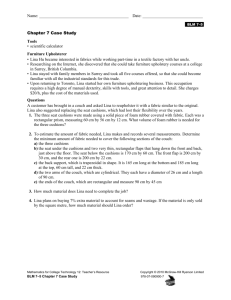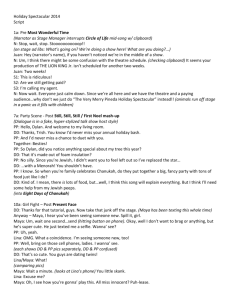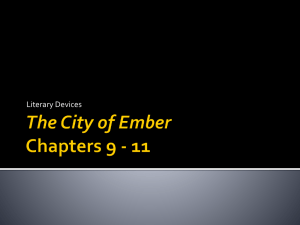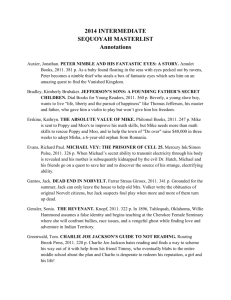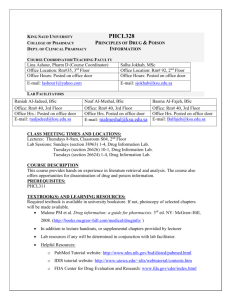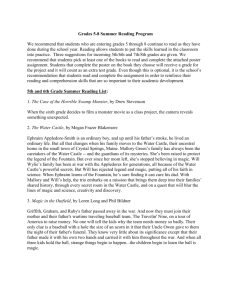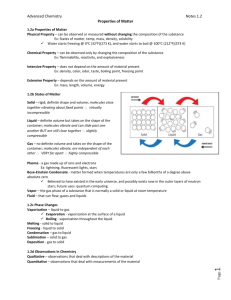Supplementary Online Material (doc 80K)
advertisement
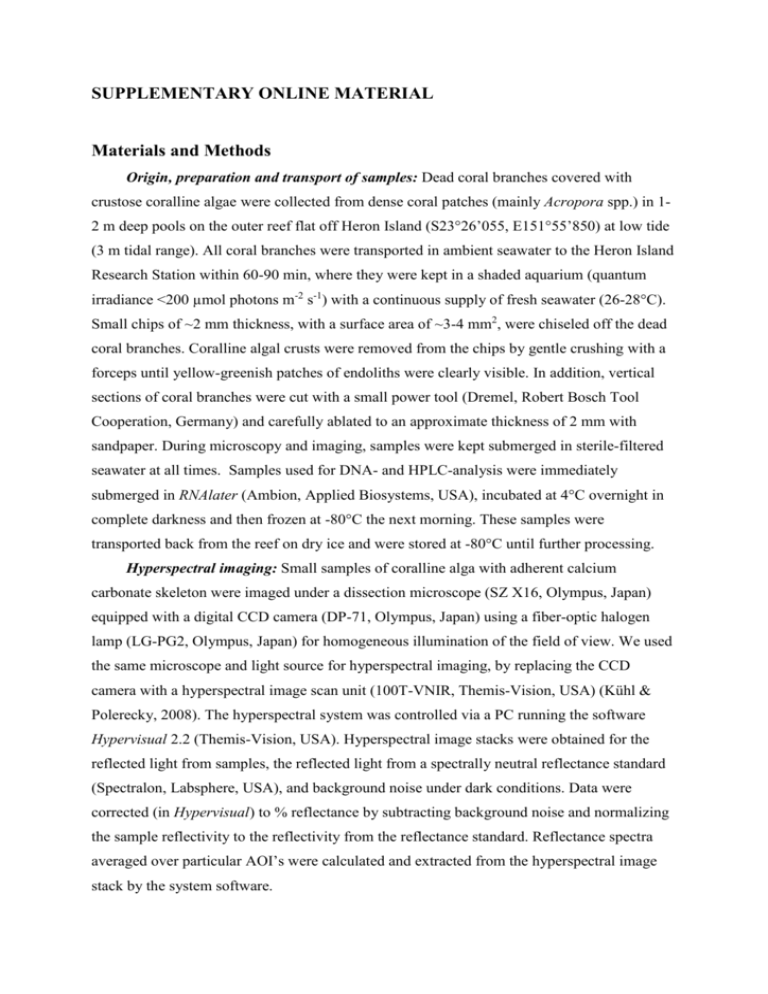
SUPPLEMENTARY ONLINE MATERIAL Materials and Methods Origin, preparation and transport of samples: Dead coral branches covered with crustose coralline algae were collected from dense coral patches (mainly Acropora spp.) in 12 m deep pools on the outer reef flat off Heron Island (S23°26’055, E151°55’850) at low tide (3 m tidal range). All coral branches were transported in ambient seawater to the Heron Island Research Station within 60-90 min, where they were kept in a shaded aquarium (quantum irradiance <200 µmol photons m-2 s-1) with a continuous supply of fresh seawater (26-28°C). Small chips of ~2 mm thickness, with a surface area of ~3-4 mm2, were chiseled off the dead coral branches. Coralline algal crusts were removed from the chips by gentle crushing with a forceps until yellow-greenish patches of endoliths were clearly visible. In addition, vertical sections of coral branches were cut with a small power tool (Dremel, Robert Bosch Tool Cooperation, Germany) and carefully ablated to an approximate thickness of 2 mm with sandpaper. During microscopy and imaging, samples were kept submerged in sterile-filtered seawater at all times. Samples used for DNA- and HPLC-analysis were immediately submerged in RNAlater (Ambion, Applied Biosystems, USA), incubated at 4°C overnight in complete darkness and then frozen at -80°C the next morning. These samples were transported back from the reef on dry ice and were stored at -80°C until further processing. Hyperspectral imaging: Small samples of coralline alga with adherent calcium carbonate skeleton were imaged under a dissection microscope (SZ X16, Olympus, Japan) equipped with a digital CCD camera (DP-71, Olympus, Japan) using a fiber-optic halogen lamp (LG-PG2, Olympus, Japan) for homogeneous illumination of the field of view. We used the same microscope and light source for hyperspectral imaging, by replacing the CCD camera with a hyperspectral image scan unit (100T-VNIR, Themis-Vision, USA) (Kühl & Polerecky, 2008). The hyperspectral system was controlled via a PC running the software Hypervisual 2.2 (Themis-Vision, USA). Hyperspectral image stacks were obtained for the reflected light from samples, the reflected light from a spectrally neutral reflectance standard (Spectralon, Labsphere, USA), and background noise under dark conditions. Data were corrected (in Hypervisual) to % reflectance by subtracting background noise and normalizing the sample reflectivity to the reflectivity from the reflectance standard. Reflectance spectra averaged over particular AOI’s were calculated and extracted from the hyperspectral image stack by the system software. Variable chlorophyll fluorescence measurements: In order to determine whether areas containing Chl d exhibited active photosynthesis, we monitored the distribution of photosynthetic activity in specific areas of the coral samples by variable chlorophyll fluorescence imaging. We used a new RGB-microscopy pulse-amplitude modulated (PAM) variabla chlorophyll imaging system (RGB-Imaging-PAM, Walz GmbH, Germany) mounted on an epifluorescence microscope (Axiostar Plus, Carl Zeiss MicroImaging GmbH, Germany), fitted with a 10x objective (Zeiss Plan-Apochromat, NA 0.45; Carl Zeiss MicroImaging GmbH, Germany). For measurements three different measuring/actinic lights (red at 620 nm, green at 520 nm, and blue at 460 nm) were used simultaneously (white light). Pulse-amplitude modulated variable chlorophyll fluorescence imaging systems have been described in detail elsewhere (Schreiber 2004, Ralph et al. 2005). Sample chips were mounted in seawater on a slide with ~4 mm deep wells mounted with a cover slip and placed on a custom built temperature controlled holder, set to 27°C. After focusing onto the chip surface, the sample was allowed to dark-adapt for 15 min before further measurements. The pulsemodulated measuring light was sufficiently weak (<0.5 μmol photons m-2 s-1) to be considered non-actinic during assessment of the minimal fluorescence yield, F0, of the dark-adapted sample. Using the saturation-pulse-method (Schreiber 2004, Baker 2008), images of the maximal quantum yield of PSII photosynthetic energy conversion, (ΦPSII)max= (Fm-F0)/Fm, and of the effective quantum yield of PSII, ΦPSII = (F’m-F)/F’m, were measured at defined levels of actinic light, i.e. photosynthetically active radiation (PAR, in units of µmol photons m-2 s-1). Relative rates of PSII-driven electron transport were calculated as: rETR = ΦPSII × PAR. Pigment-analysis: Extraction of pigments was performed on either randomly chosen coralline algal crusts samples of 0.5-1 cm2 from ~10 coral branches, or on small chips of a few mm2 that were chosen due to yellow coloration and their absence of crustose coralline algae (n=5). Pigments of crushed sampled were extracted into 100% methanol for 30 minutes at 4°C in the dark and analyzed by high performance liquid chromatography (HPLC) (C18, 250 mm x 4.6 mm, Synergi Fusion) using an CH3CN-CH3OH gradient as described in Mohr et al (S3). DNA extraction: Samples stored in RNAlater (Ambion, Applied Biosystems) were crushed in pre-cleaned and sterilized mortars using liquid nitrogen. The resulting powder was immediately processed using the standard FastDNA for soil kit (QBIOgene), with two additional bead-beating cycles. Samples were cooled 2 min. on ice between each of the beadbeating cycles. The resulting DNA was eluted in TAE buffer and the DNA was quantified using a BioPhotometer (Eppendorf, Hamburg, Germany), checked for integrity on a 0.8 % agarose gel and stored at -20°C until further use. PCR amplification and pyrosequencing: The DNA concentration in all samples was adjusted to 5 ng/µl using water. Tag-encoded amplicon pyrosequencing was performed on DNA extracted from three biologically independent samples. Briefly, a 466 bp fragment of 16S rDNA was amplified using the primers: 341F (CCTAYGGGRBGCASCAG) and 806R (GGACTACNNGGGTATCTAAT) flanking the V3 and V4 regions (Youngseob et al., 2005). The PCR amplification was done using 1 X Phusion HF buffer, 0.2 mM dNTP mixture, 0.8 U Phusion Hot Start DNA Polymerase (Finnzymes Oy, Espoo, Finland), 0.5 µM of each of the primers 341F and 806R and 1 µl diluted DNA sample. The PCR incubation conditions were: 98°C for 30s, followed by 35 cycles at 98°C for 5s, 56°C for 20s and 72°C for 20s and a final extension time of 72°C for 5 minutes. Following the PCR amplification the samples were kept at 70°C for 3 minutes and then moved directly onto ice to prevent hybridization between PCR products and short nonspecific amplicons. Analysis of PCR products was done on a 1% agarose gel. The specific bands were cut from the agarose gel and purified using the standard protocol of the Montage Gel extraction kit (Millipore). A second round of PCR was performed as described above, except that this time primers with adapters and tags were used (Table S1) and the number of cycles was reduced to 15. Again, the specific bands were cut from the agarose gel and purified by Montage gel extraction. The amplified fragments with adapters and tags were quantified using the Qubit™ fluorometer (Invitrogen) and mixed in approximately equal concentrations (5x107 copies per µl) to ensure equal representation of each sample. DNA samples were sequenced on one of two-regions of 70_75 GS PicoTiterPlate (PTP) by using a GS FLX pyrosequencing system (Roche) according to the manufacturer instructions. Sequence analysis: Sorting and trimming of sequences >150 bp in length was performed by the Pipeline Initial Process at the RDP's Pyrosequencing Pipeline (http://rdp.cme.msu.edu/; Cole et al., 2008). After this filtering step, 17,065 reads were left for subsequent sequence analysis. Preliminary taxonomic classification was done with the RDP classifier (ver. 2.1) software, which was run locally using the Training Data 5 set as a reference. A confidence threshold of ≥50% was chosen as the requirement for accurate genuslevel determination. Accordingly, sequences assigned to a genus with <50% confidences were deemed as unclassified. Reads classified by the RDP as “Chloroplasts” were removed from the data set to limit contamination of false positives. Further genus verification and specieslevel classification/OTU picking was done on the remaining 6289 reads using the UCLUST/USEARCH software (http://www.drive5.com/usearch/) in the following manner: A large FASTA-formatted file containing all sequence reads was created, in which sequence names were fitted with unique sample-name prefixes. Reads were subsequently clustered at ≥97% identity (with the 'optimal' option enabled), yielding 429 distinct OTUs. A local PERL script was then used for parsing the UCLUST output and picking OTUs representatives. Representative sequences from each OTU were identified using the search option against a locally curated database of ~45,000 non-redundant (nr100) 16S rRNA sequences from the RDP Database (release 10.20). The reference set was truncated to the V3V4 hyper variable regions. Scanning electron microscopy: Samples used for imaging were stored in RNAlater solution and were fixed in 2% glutaraldehyde in 0.05 M sodium phosphate buffer, pH 7.4. Following 3 rinses in 0.15 M sodium cacodylate buffer (pH 7.4) specimens were post fixed in 1% OsO4 in 0.12 M sodium cacodylate buffer (pH 7.4) for 2 h. Following a rinse in distilled water, the specimens were dehydrated to 100% ethanol according to standard procedures and critical point dried (Balzers CPD 030, Balzers, Switzerland) employing CO2, and the specimens were subsequently mounted on stubs using colloidal coal as an adhesive, and sputter coated with gold (SEM Coating Unit E5000, Polaron). Specimens were examined with a XL FEG 30 (Philips, Netherlands) scanning electron microscope operated at an accelerating voltage of 2 kV. Supplementary references Baker NR (2008) Chlorophyll fluorescence: A probe of photosynthesis in vivo. Ann Rev Plant Biol 59:89-113. Cole JR, Wang Q, Cardenas E, Fish J, Chai B, Faris RJ et al. (2008). The ribosomal database project: improved alignments and new tools for rRNA analysis. Nucl Acids Res 37(Database issue):D141-D145. Kühl M, Polerecky L. (2008). Functional and structural imaging of phototrophic microbial commmunities and symbioses. Aq Microb Ecol 53:99-118. Ralph PJ, Schreiber U, Gademann R, Kühl M., Larkum AWD (2005b) Coral photobiology studied with a new imaging PAM fluorometer. J Phycol 41:335-342. Schreiber U. (2004). Pulse-amplitude-modulation (PAM) fluorometry and saturation pulse method: an overview. In Papageorgiou, GCG (ed). Chlorophyll fluorescence: a signature of photosynthesis. Kluwer: Dordrecht, pp 279-319. Youngseob Y, Lee C, Kim J, Hwang S. (2005). Group-specific primer and probe sets to detect methanogenic communities using quantitative real-time polymerase chain reaction. Biotechnol Bioengin 89:670-679. Table S2. Primers with tags and adaptors used for pyrosequencing. Primer ID Sequence LinA_341F_1 5’- GCCTCCCTCGCGCCATCAG-ACGAGTGCGT-CCTAYGGGRBGCASCAG LinA_341F_2 5’- GCCTCCCTCGCGCCATCAG-ACGCTCGACA-CCTAYGGGRBGCASCAG LinA_341F_3 5’- GCCTCCCTCGCGCCATCAG-AGACGCACTC-CCTAYGGGRBGCASCAG LinA_341F_4 5’- GCCTCCCTCGCGCCATCAG-AGCACTGTAG-CCTAYGGGRBGCASCAG LinA_341F_5 5’- GCCTCCCTCGCGCCATCAG-ATCAGACACG-CCTAYGGGRBGCASCAG LinA_341F_6 5’- GCCTCCCTCGCGCCATCAG-ATATCGCGAG-CCTAYGGGRBGCASCAG LinA_341F_7 5’- GCCTCCCTCGCGCCATCAG-CGTGTCTCTA-CCTAYGGGRBGCASCAG LinA_341F_8 5’- GCCTCCCTCGCGCCATCAG-CTCGCGTGTC-CCTAYGGGRBGCASCAG LinA_341F_9 5’- GCCTCCCTCGCGCCATCAG-TAGTATCAGC-CCTAYGGGRBGCASCAG LinA_341F_10 5’- GCCTCCCTCGCGCCATCAG-TCTCTATGCG-CCTAYGGGRBGCASCAG LinA_341F_11 5’- GCCTCCCTCGCGCCATCAG-TGATACGTCT-CCTAYGGGRBGCASCAG LinA_341F_13 5’- GCCTCCCTCGCGCCATCAG-CATAGTAGTG-CCTAYGGGRBGCASCAG LinA_341F_14 5’- GCCTCCCTCGCGCCATCAG-CGAGAGATAC-CCTAYGGGRBGCASCAG LinA_341F_15 5’- GCCTCCCTCGCGCCATCAG-ATACGACGTA-CCTAYGGGRBGCASCAG LinA_341F_16 5’- GCCTCCCTCGCGCCATCAG-TCACGTACTA-CCTAYGGGRBGCASCAG LinA_341F_17 5’- GCCTCCCTCGCGCCATCAG-CGTCTAGTAC-CCTAYGGGRBGCASCAG LinA_341F_18 5’- GCCTCCCTCGCGCCATCAG-TCTACGTAGC-CCTAYGGGRBGCASCAG LinA_341F_19 5’- GCCTCCCTCGCGCCATCAG-TGTACTACTC-CCTAYGGGRBGCASCAG LinA_341F_20 5’- GCCTCCCTCGCGCCATCAG-ACGACTACAG-CCTAYGGGRBGCASCAG LinA_341F_21 5’- GCCTCCCTCGCGCCATCAG-CGTAGACTAG-CCTAYGGGRBGCASCAG LinA_341F_22 5’- GCCTCCCTCGCGCCATCAG-TACGAGTATG-CCTAYGGGRBGCASCAG LinA_341F_23 5’- GCCTCCCTCGCGCCATCAG-TACTCTCGTG-CCTAYGGGRBGCASCAG LinA_341F_24 5’- GCCTCCCTCGCGCCATCAG-TAGAGACGAG-CCTAYGGGRBGCASCAG LinA_341F_25 5’- GCCTCCCTCGCGCCATCAG-TCGTCGCTCG-CCTAYGGGRBGCASCAG LinA_341F_25 5’- GCCTCCCTCGCGCCATCAG-TCGTCGCTCG-CCTAYGGGRBGCASCAG LinA_341F_26 5’- GCCTCCCTCGCGCCATCAG-ACATACGCGT-CCTAYGGGRBGCASCAG LinA_341F_27 5’- GCCTCCCTCGCGCCATCAG-ACGCGAGTAT-CCTAYGGGRBGCASCAG LinA_341F_28 5’- GCCTCCCTCGCGCCATCAG-ACTACTATGT-CCTAYGGGRBGCASCAG LinA_341F_29 5’- GCCTCCCTCGCGCCATCAG-ACTGTACAGT-CCTAYGGGRBGCASCAG LinA_341F_30 5’- GCCTCCCTCGCGCCATCAG-AGACTATACT-CCTAYGGGRBGCASCAG LinA_341F_31 5’- GCCTCCCTCGCGCCATCAG-AGCGTCGTCT-CCTAYGGGRBGCASCAG LinA_341F_32 5’- GCCTCCCTCGCGCCATCAG-AGTACGCTAT-CCTAYGGGRBGCASCAG LinA_341F_33 5’- GCCTCCCTCGCGCCATCAG-ATAGAGTACT-CCTAYGGGRBGCASCAG LinA_341F_34 5’- GCCTCCCTCGCGCCATCAG-CACGCTACGT-CCTAYGGGRBGCASCAG LinA_341F_35 5’- GCCTCCCTCGCGCCATCAG-CAGTAGACGT-CCTAYGGGRBGCASCAG LinB_806R 5’- GCCTTGCCAGCCCGCTCAG-GGACTACNNG-GGTATCTAAT Supplementary figure legends: Fig. S1. Cross section through a crustose coralline covered coral showing the presence of a thin Chl d-containing biofilm. (A) Schematic representation of the distribution of phototrophs and light through a crustose coralline alga with the underlying community of Chl d-containing cyanobacteria and other endoliths. (B) Hyperspectral reflectance image (710 nm) of a cross section, showing the presence of Chl d as dark areas. Numbers refer to the spectra displayed in panel C. (C) Reflectance spectra from the four AOI’s labeled in (B) showing Chl d absorption around 710 nm. Fig. S2. HPLC chromatograms and spectral characteristics of eluents from two samples of encrusting coralline algae and their underlying biofilm. Besides a major Chl a signal (at ~20.6 min), the samples contained detectable amounts of Chl d (at ~18.6 min) and trace amounts of Chl b. Chl d absorbs maximally at ~696 nm in methanol (indicated with arrows). (A) Chromatogram of unsorted samples largely with intact coralline algae on top (B) Chromatogram of sorted samples with the coralline red algal layer partly removed and presence of a yellow-greenish biofilm. (C) and (D) HPLC spectra referring to panels (A) and (B), respectively. Fig. S3. DNA pyrosequencing based taxonomic distribution of dominant prokaryotes in crustose coralline algae and their associated endolithic communities in the 1-2 mm thick carbonate skeleton below. At the phylum level, 16S rDNA assignments were done using the RDP classifier, whereas species-level classification is based upon UCLUST/USEARCH results. The extruded pie slice shows the percentage of Acaryochloris marina within the phylum Cyanobacteria. Percentages represent the average of three independent replicates.
